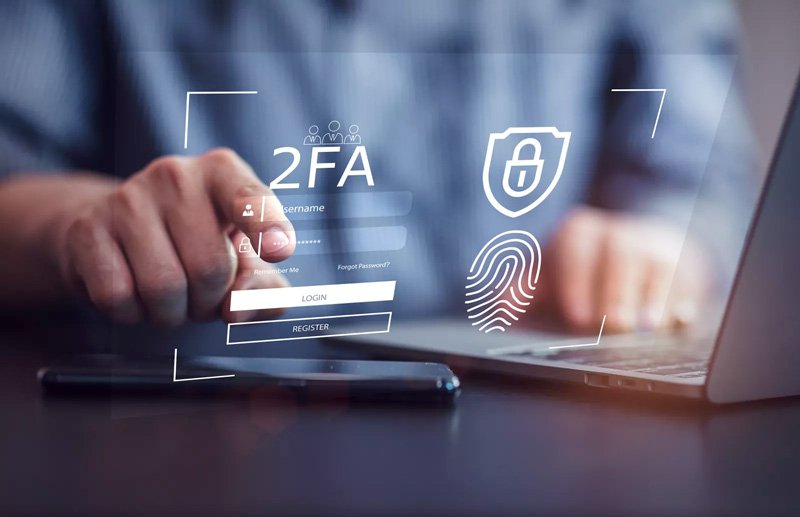
Many cryptocurrency holders underestimate one crucial topic: two-factor authentication (2FA). I’ve met people who see 2FA as complicated, tedious, and unnecessary—something they can learn about later. Today, I’m here to explain why it’s so important, and why just using a password isn’t enough… By the end, you’ll see that it’s simple. The crypto world is full of people looking to steal your funds, so it’s better to learn this lesson the easy way.
It might sound dramatic, but it’s true: not using 2FA can cost you everything, from your job that supports your family to your life savings. The crypto world offers incredible freedoms, but it also requires a lot of responsibility. If you make a mistake, like sending funds to the wrong address or having someone access one of your accounts, no customer service will save you.
Let’s start by defining what 2FA is, which stands for “Two Factor Authentication”. It’s a security method that requires two verification forms to confirm your identity when accessing an account. The term “two-factor authentication” comes from the need for an extra password or PIN, along with a device capable of running an authentication app like Google Authenticator or Authy. So, how does 2FA benefit you? Consider phishing attacks—they aim to trick users into revealing their passwords… With 2FA enabled, even if the attacker obtains the password, they won’t be able to access the account.
Never underestimate the malicious intent behind phishing attacks. Trust me, I speak from experience. For the past few months, my inbox has been flooded with emails from scammers posing as Blockfi, urging me to log in to my account via some fake URL. This is happening because Blockfi, which filed for bankruptcy in 2022, is now refunding users through the firm Kroll. But here’s the kicker: a few months ago, there was a massive data breach involving Kroll’s management, exposing many users’ emails… Sometimes, even passwords end up leaked online.
These warnings aren’t just for cryptocurrency users; they’re for everyone. Imagine you’re responsible for managing an account holding funds for multiple clients, and someone guesses the password and gains access. Without a 2FA setup, you’d be solely responsible for any consequences. That’s why it’s crucial to understand this: relying on an old password isn’t enough; you need to add security layers. However, it’s important to realize that 2FA isn’t foolproof. Malware can intercept passwords and 2FA codes directly from a victim’s device, and there’s also the risk of SIM swapping, where attackers collaborate with phone company employees to transfer your number to a SIM card they control.
This is not about finding a perfect security method; it’s about arming yourself with the most effective protection techniques… Next up, we’ll delve into some of the most popular and widely used authentication methods, and show you how to implement them. You’ll see that it’s quite simple and doesn’t require extensive tech knowledge.
- Authentication apps (Google Authenticator, Authy, Microsoft Authenticator…): these are apps that generate temporary codes updated every 30 seconds. After entering your username and password on a specific site, you just have to open the authentication app, copy the provided code for the desired app or service, and paste it into the appropriate field. It’s also crucial to activate this feature to ensure that any cryptocurrency service you use requires it for withdrawals. A single authentication app can provide codes for multiple applications.
- Text messages (SMS) and emails: these methods provide an extra layer of security for accessing many services, whether it’s a digital wallet or a centralized exchange. To activate authentication via SMS, simply navigate to the desired service and enable the option (usually found in settings). Upon entering your username and password during login, a text message containing a verification code will be sent to your mobile phone. This code is typically required for specific actions within the service, such as fund withdrawals or updates to personal information. Email authentication works similarly; for example, when withdrawing funds from Binance, you may be prompted to enter both an authentication code and a numerical PIN sent to your email address.
- Hardware Tokens: we are talking about physical devices that generate 2FA codes and can connect to other devices via USB, NFC, or Bluetooth. Examples include YubiKey and Google Titan Security Key. Hardware tokens do not rely on internet connectivity to function. However, they tend to be pricey, and losing a hardware device containing crucial codes can be troublesome. In such cases, you’ll need to contact customer service (such as Binance, Coinbase, Bitfinex, etc.), provide requested documentation to verify account ownership, and wait for the process to be completed, which may take several days.
- Biometrics: This method uses fingerprints, facial scans, or voice recognition, making it a convenient and quick alternative to remembering codes. However, its effectiveness relies on the technology and precision of your device.
Subscribe to our Newsletter and follow us on social media for updates on crypto events and news about Hamza.biz, the first Web3 e-commerce platform powered by the Loadpipe protocol. This innovative solution offers a new governance model, low gas fees, and access to multiple cryptocurrencies.
- 2FA (4)
- authentication (1)
- authy (1)
- biometrics (1)
- Blockchain (92)
- crypto events (3)
- cryptocurrencies (80)
- e-commerce (56)
- google authenticator (1)
- google titan security key (1)
- Hamza.biz (65)
- hardware tokens (1)
- loadpipe (42)
- malware (1)
- newsletter (11)
- phishing (4)
- protocol (2)
- security (16)
- sim swapping (1)
- two-factor authentication (1)
- yubikey (1)